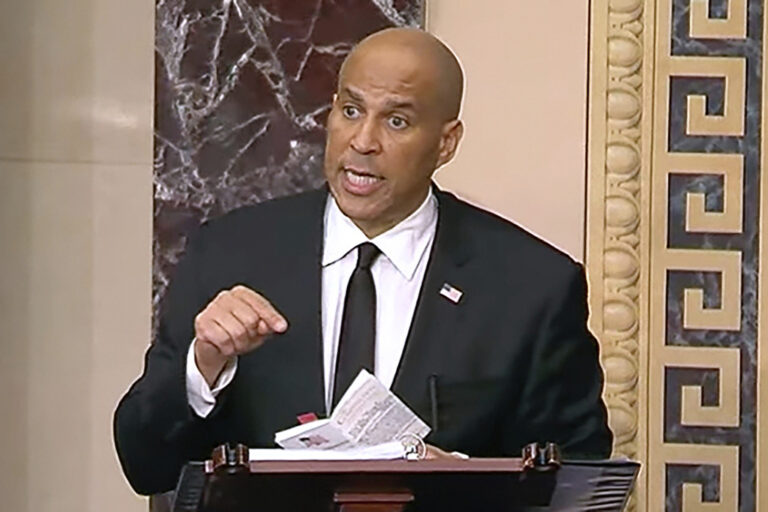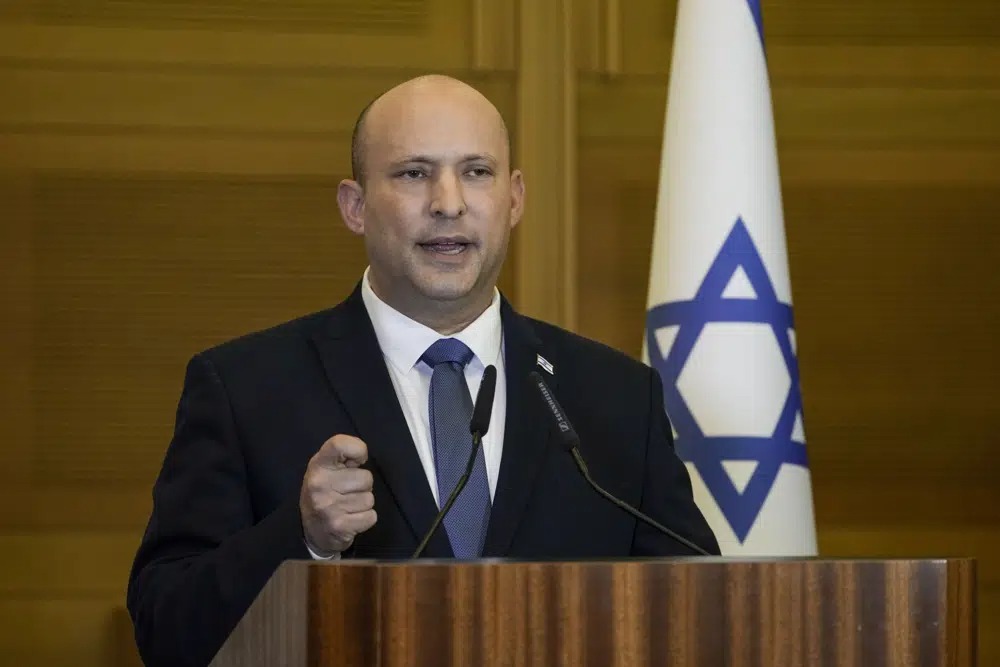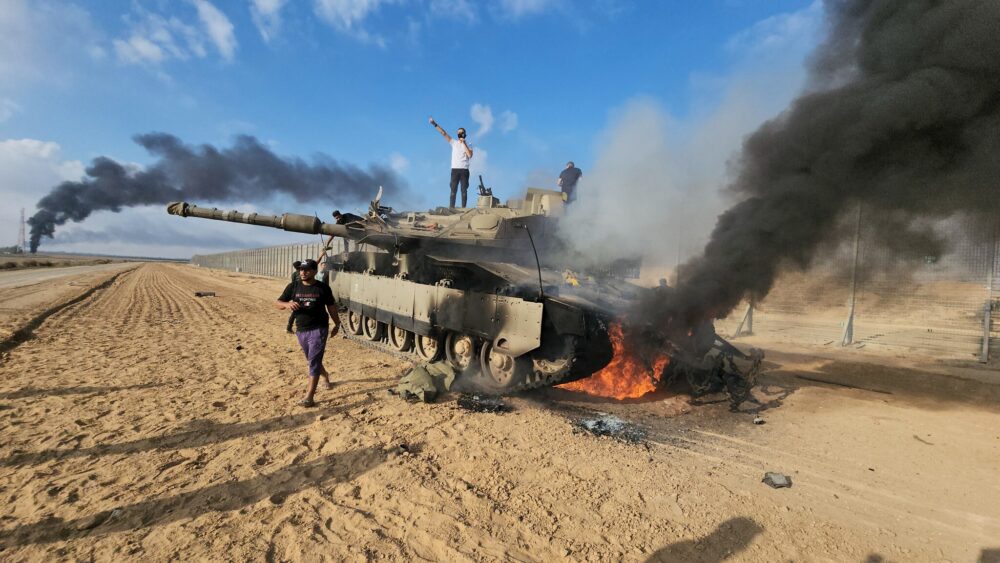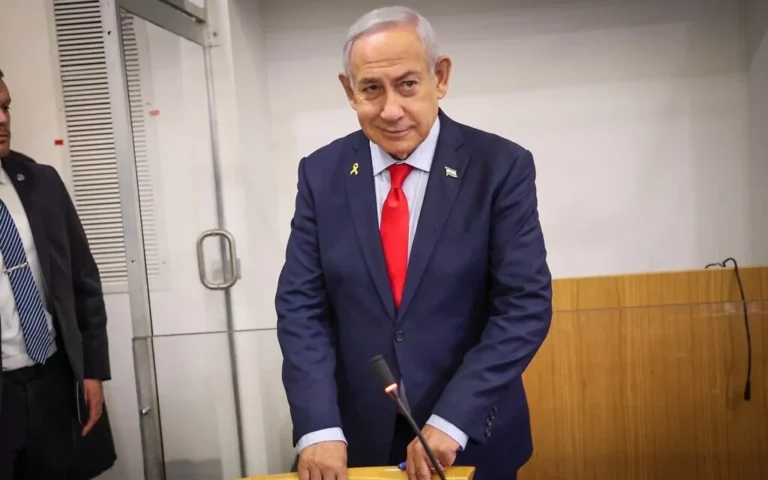In February, with the images of the violent insurrection in Washington still fresh in the minds of Americans, newly confirmed Defense Secretary Lloyd Austin took the unprecedented step of signing a memo directing commanding officers across the military to institute a one-day stand-down to address extremism within the nation’s armed forces.
The stand-down came in response to the participation and the subsequent arrests of several veterans and at least one active duty service member, who along with thousands of supporters of former President Donald Trump on Jan. 6, stormed the U.S. Capitol in a melee that sent lawmakers scrambling for safety, left one person fatally shot by Capitol Police and caused millions of dollars in damages to the building largely seen as the symbol of American democracy.
Austin’s order, which also came as America as a whole was grappling with how to address systemic racism, was the latest in a series of decades-long efforts by the military to purge its ranks of extremists and white supremacists. Last week, in response to the order the military issued new rules to deal with extremism that included social media usage policy updates where liking and reposting white nationalist and extremist content could result in disciplinary action. The DOD also updated its screening of recruits and is looking at how to prepare troops who are retiring from being targeted by extremist organizations.
But an AP investigation found that despite the new rules, racism and extremism remain an ongoing concern in the military.
The investigation shows the new guidelines do not address ongoing disparities in military justice under the Uniform Code of Military Justice, the legal code that governs the U.S. armed forces. Numerous studies, including a report last year from the Government Accountability Office, show Black and Hispanic service members were disproportionately investigated and court-martialed. A recent Naval Postgraduate School study found that Black Marines were convicted and punished at courts-martial at a rate five times higher than other races across the Marine Corps.
The AP investigation also shows the military’s judicial system has no explicit category for bias-motivated crimes – something the federal government, at least 46 states, and the District of Columbia have on the books – making it difficult to quantify crimes prompted by prejudice.
As a result, investigative agencies such as the Naval Criminal Investigative Service or Army Criminal Investigative Division also don’t have a specific hate crime category, which impacts how they investigate cases.
“While it’s possible hate crimes have occurred, our investigations are not titled as such,” the NCIS said in an email. “For example, an assault on a person, regardless of the reason for the assault, would still be categorized as an assault…regardless of what motivated the crime.”
The new National Defense Authorization Act signed into law by President Biden on Monday directs the Secretary of Defense to make a recommendation to Congress within 180 days if a new statute is needed to address violent extremism, but does not address hate crimes or racial disparities in military law.
The new Pentagon rules do not outright ban service members from being members of extremist organizations, such as the Ku Klux Klan, Oath Keepers, or other right-wing and white nationalist groups. The regulations, like the previous ones, only prohibit “active participation,” in such groups, a murky policy that civil rights organizations have raised concerns about for years. The military describes active participation as “publicly demonstrating or rallying, fundraising, recruiting and training members,” as well as organizing or leading organizations.
Experts interviewed by the AP say there’s also ongoing concern over the military commander’s ability to enact a wide range of administrative and disciplinary actions — including administrative separation or appropriate criminal action — against military personnel who engage in prohibited activities.
Commanders essentially have total discretion to determine how to address situations as they arise, which experts say has created non-uniform, scattershot enforcement, with some commanders establishing a no-tolerance approach and others employing weak enforcement of the rules.
The AP investigation also found that while the DOD says it considers racism and extremism within the military to be a “security concern,” it does not have funding that specifically supports efforts to address extremism. Instead, military officials said the Pentagon uses personnel vetting programs, training, and education programs, and the Insider Threat Program to “positively contribute to countering extremism within the force.”
The Pentagon did not respond to questions about how much money it has spent or budgeted for efforts solely related to diversity and inclusion, and how many employees are dedicated to it. Officials also did not respond to dozens of questions from the AP on how it plans to enforce its new guidelines on extremism.
Pentagon Spokesperson Maj. César Santiago acknowledged in a statement to the AP that extremism and extremist ideology can have an outsized effect on the military force.
But he added: “The vast majority of the women and men in uniform serve their nation with honor and integrity.” He said since taking office in January, Secretary Llyod Austin, the first African American to serve as Secretary of Defense, has taken immediate action to address extremism. In addition to the new guidelines on extremism, the Defense Department appointed an interim deputy inspector general for diversity and inclusion and military insider threats in April.
Susan Corke, the director of the Southern Poverty Law Center’s Intelligence Project, commended the DOD for taking key steps this year, including the changes announced last week, to address extremism. She said the DOD sought the expertise of civil rights organizations, academics, and others who have sounded the alarm about the dangers of extremism in the ranks for years.
But Corke said it’s too soon to definitively say whether the updated policies will purge extremism from military ranks.
“The devil will be in the details,” she said. “ I do appreciate that there is a commitment from the Defense Department to have much more consultation with outside partners and that there’s much more focus on doing additional research. So, we’re going to hold their feet to the fire.”
Corke said the SPLC is still pressing for additional reforms, including how the military’s command structure allows commanders to have virtually absolute command authority over subordinates, which might discourage members from reporting incidents or concerns of extremism.
Even some in the military agree that the armed forces need to do more. “There needs to be a change in action and behaviors – elements that can’t be so easily influenced by a change in military law, ″ said Maj. Tyrone Collier, a judge advocate in the Marine Corps Reserve, in an interview with the AP.
“Even if some legislation is passed from the highest echelons of government that says you will do this and that, will it actually get done?” Collier said.
DECADES OF REPEATED WARNINGS
Extremism and racism in the military are hardly new. Racist attitudes and discrimination against people of color in the military were official policies before President Harry Truman, on July 26, 1948, signed Executive Order 9981, which officially desegregated the armed forces. Still, many units remained segregated until late 1954.
In the 1960s, Black soldiers in Vietnam filed numerous complaints with the Pentagon about white soldiers flying Confederate flags. Following the death of civil rights leader Martin Luther King Jr. in 1968, white U.S. service members based at the Cam Ranh Bay, South Vietnam naval base, celebrated his death by parading around the base in Ku Klux Klan-style white sheets and hoisted a Confederate flag atop the headquarters building, according to the 1997 book “Fighting on Two Fronts: African Americans and the Vietnam War.”
In the 1970s, extremism in the military gained national attention when the Ku Klux Klan was found to be operating openly at Camp Pendleton, a U.S. Marine Corps base in southern California. White Marine klansmen openly distributed racist literature on the base, pasted KKK stickers on barracks doors, and hid illegal weapons in their rooms. The hate group’s presence on the base came to light in 1976 when 14 Black Marines were charged with assault when they broke into the wrong room and attempted to break up what they thought was a party of klansmen.
In June of 1986, the Southern Poverty Law Center’s Klanwatch Project issued one of the first of many warnings to the DOD about white supremacists in its ranks and urged then-Defense Secretary Caspar Weinberger to bar active duty service members from belonging to Ku Klux Klan factions. The center at that time alleged it had evidence, including photos, of active-duty U.S. Marines who had participated in the Confederate Knights of the Ku Klux Klan, a North Carolina-based Klan faction that changed its name last year to the White Patriot Party.
“It is simply intolerable that members of the U.S. armed forces, sworn to uphold and defend the constitution of the United States, be allowed to hold membership in an organization which seeks to overthrow the federal government through violent means,” the SPLC wrote.
The military responded by saying it found no evidence to support those allegations and while it strongly discouraged membership by military personnel in organizations “which have clear racist objectives, we also realize that our military personnel do not forfeit their constitutional rights under the First Amendment upon entry into the military service. Thus DoD does not prohibit personnel from joining such organizations as the Ku Klux Klan.”
Weinberger did issue a directive instructing service members to “reject participation in white supremacy, neo-Nazi and other such groups which espouse or attempt to create overt discrimination.”
But critics say the military’s response fell short and failed to meet the moment by not instituting new, stricter policies.
In 1995, extremism in the military was thrust into the national spotlight again when three white Army paratroopers at Fort Bragg in North Carolina were arrested in the murder of a Black couple, Michael James and Jackie Burden, who they shot and killed in downtown Fayetteville. Two of the paratroopers, James Burmeister and Malcolm Wright, were sentenced to life in prison. Another 19 Fort Bragg soldiers were discharged for taking part in neo-Nazi activities.
Burmeister had made no attempts to hide his beliefs: Police found a Nazi flag over his bed and white supremacist pamphlets and instructions for making bombs in a room he rented off base. Earlier that year, Army veteran Timothy McVeigh, an anti-government extremist who earned a Bronze Star in Operation Desert Storm, parked a truck with a homemade bomb in front of a federal building in Oklahoma, killing 168 people, including 19 children.
The Pentagon, again, pledged after the slayings to address extremism within its ranks. Congressional leaders held hearings and the Army formed an extremism task force. But military leadership said the task force found minimal evidence of extremist activity in the Army.
“The SPLC has been writing to Defense Department officials about our concerns about white supremacy, white nationalism in the military since the mid-1980s,” said Margaret Huang, the president and CEO of the Southern Poverty Law Center. “This has been an issue that we’ve talked about quite a number of times because it has been a significant problem in the U.S. military for many decades now.”
A 2005 Defense Department report, “Screening for Potential Terrorists in the Enlisted Military Accessions Process,” noted that the Pentagon has established numerous policies defining and restricting participation in extremist organizations. But it also found that “effectively, the military has a “don’t ask, don’t tell” policy pertaining to extremism.”
“If individuals can perform satisfactorily, without making their extremist opinions overt through words or actions that violate policy, reflect poorly on the Armed Forces, or disrupt the effectiveness and order of their units, they are likely to be able to complete their contracts,” the report read. “This reality demonstrates the balance the Armed Forces have achieved between screening for extremists while respecting privacy and preserving federally protected rights to freedom of speech, religion, and association.”
In July 2009, civil rights organizations again wrote to the DOD. This time to then-Secretary of Defense Robert Gates urging the Obama Administration to take appropriate measures to deal with extremists in the ranks. No sweeping action was taken.
The guidelines last week represent a major step on guidance for troops’ social media usage. Retweeting or liking extremist content will now be viewed as advocating the content. The new rules do not provide a list of extremist organizations that troops should not actively participate in.
Retired Air Force Col. Don Christensen, who served as the chief prosecutor for the U.S. Air Force between 2010 and 2014, said the new policies are “loosely defined,” and “lack guidance” in terms of what organizations service members should not interact with.
He also said that the new policies are unclear on how commanders would enforce the social media rules.
“I understand this stuff is hard, but the like button means so many different things to different people. My main takeaway is this isn’t going to be enforceable. There’s a lot of subjectivity.” Christensen said. “I also think they (the Defense Department) are naive to think it’s a small number of service members who engage in extremist activity.”
The DOD said it is commissioning a study to determine the extent of extremism in the military.
But in its report last week, the Pentagon said prohibited extremist activity among service members was rare.
“The military itself doesn’t know the extent of the problem,” said Mark Pitcavage, a senior research fellow at the Anti-Defamation League, who testified before Congress in February 2020 about the dangers of extremism within the military, one year before the insurrection.
Pitcavage told Congress in 2020 that the ADL had reported 72 suspected white supremacists to the various branches in a three-year span, including 38 in the Army, two in the Army National Guard, four in the Navy, 19 in the Marine Corps, two in the Air Force, and one in the Coast Guard, as well as six with an indeterminate service branch. The DOD said it found fewer than 100 military members who were involved in substantiated cases of extremist activity in the past year.
“There’s no safe number of extremists in the military,” Pitcavage said.
MORE CHANGES NEEDED
U.S. Rep. Jason Crow, a Colorado Democrat, was one of the many members of Congress trapped in the House Chamber gallery on Jan. 6. as chaos erupted when a mob of insurrectionists stormed the U.S. Capitol.
As the mob breached the outer security perimeter and began banging on the gallery doors in an attempt to break down the makeshift barricades, Crow urged other members amid the pandemonium to remove their congressional lapel pins because he worried that if the mob had broken through the door, “they were going to try to kill members.”
They were eventually rescued but Crow said a conversation from that day with a fellow Black Democratic congresswoman remains firm in his mind. He said the congresswoman thanked him for urging members to remove their pins in an effort to remain undetected by the mob but she told Crow that as a Black woman, she would have never been able to blend in, unlike her white counterparts.
“That was the first time in my life that I was on the receiving end of the violence of racism and white supremacy in our nation’s history,” Crow said in an AP interview earlier this year.
Crow, a former Army Ranger and Iraq War veteran, who is a member of Congress’ House Armed Services Committee, introduced legislation last year called the Realizing Efforts for Military Equity, Diversity and Inclusion Act. It would require and create a more rigorous diversity training program for troops, contractors, and civilian staff members at the Defense Department. The legislation was passed this month as part of the National Defense Authorization Act.
Crow said last week it’s too soon to determine whether the Pentagon’s policy updates are enough to weed out extremism, but he believes Austin is the right person to tackle the decades-long issue.
But Crow said he’s planning to have conversations with the Pentagon about its updated policies, including the fact that members are still allowed to be members of extremist organizations as long as it isn’t “active” participation.
“Membership in some of these groups does give me concern and it does potentially send the wrong message,” Crow said. “The military is all about trust. It’s all about making sure that you trust the person on your right and your left. Membership in some of these extreme organizations go right to the core of undermining that trust.”
Experts on extremism say the military’s efforts to address racism and white supremacy need to start before recruits actually join the various services. One key area: vetting recruit’s social media posts.
The Pentagon said it has a robust screening procedure, including a fingerprint check and an FBI background check. Recruits are also screened for offensive, racist, or supremacist tattoos.
But it doesn’t currently “have the capability to conduct social media screenings,” DOD officials said in a statement.
During last week’s press conference announcing the new guidelines on extremism Kirby also emphasized that the DOD does not screen service members’ social media posts for extremist content: “There’s no methodology in there. There’s no ability for the Department of Defense to monitor the personal social media accounts of every member of the armed forces.” He said when commanders are notified of problems through “various streams of reporting,” they would be expected to speak to troops to determine whether further steps were needed.
Veteran groups and experts on hate groups said the military also needs to do more to address extremism in those separating from active duty. The modern white power movement was born out of the 1970s when disillusioned Vietnam War veterans began to be recruited by white power militia groups, according to research by Kathleen Belew, an assistant professor of History at the University of Chicago.
Under the new guidelines, the DOD said it would develop programs to prepare troops who are leaving the service from being targeted by extremist organizations. Numerous studies have shown that some veterans are much more likely to be targeted for recruitment in the white extremist fringe, compared to the civilian population, and they are disproportionately involved in acts of violence.
The most recent study, an October research brief by the National Consortium for the Study of Terrorism and Responses to Terrorism, found that from 1990 through the first nine months of 2021, at least 458 criminal extremists with U.S. military backgrounds committed criminal acts that were motivated by their “political, economic, social, or religious goals.”
That figure includes 118 individuals who are facing charges for their involvement in the Capitol insurrection. Of the 458 people, 83.6%, or 383, were no longer serving when they were arrested for committing extremist crimes.
“Overall, numerically, this is still a small but growing problem,” said William Braniff, the director of the National Consortium for the Study of Terrorism and Responses to Terrorism and a University of Maryland professor, during a Brookings Institute panel on extremism in the military earlier this month.
“It’s a national security concern,” Braniff said. “So, this is really creating a soft underbelly in American society. So, it’s not just a numbers problem. I think this is a problem regarding American democracy. And it’s a problem for which we have to put a preventative ecosystem in place now before the numbers do get more concerning.”
EVERYDAY RACISM
Veterans like Reuben Keith Green said it’s disheartening to see the military struggling decade after decade to deal with racism and extremism in its ranks.
Green, 64 and a retired Navy Lt. Cmdr., was part of generations of men in his family who joined the military. Both his father and grandfather served. But he grew disillusioned by the military and what he believed were broken promises that all servicemen and women were equal and would be treated the same regardless of race.
He said he endured and witnessed countless acts of racism through his time in the service from when he first enlisted on Valentine’s Day in 1975 to when he left in the mid-’90s. Some fellow service members, he said, proudly displayed Confederate flags and expressed white supremacist views, with no retribution. Green wrote a book in 2017, “Black Officer, White Navy,” that detailed his personal experiences. He’s also penned several articles, demanding military accountability.
This year, he said he served as a guest speaker for a Pentagon program that was part of Secretary Lloyd Austin’s extremism stand-down.
But Green said while the stand-down was a step in the right direction, he believes the military has yet to address the “everyday racism that is based on extremist views.”
Green said he worries the policies released last week won’t move the needle. He also questioned whether military officials will be able to uniformly enforce and establish “intent” behind a service member’s decision to like or share extremist views and posts on social media.
“If my CO (commanding officer) is a member of the KKK, am I going to report discrimination or extremist behavior to him or her?” Green said.
He also noted that none of the policies specifically address acts of discrimination or racism that are not “violent” in nature but could still have disastrous impacts on unit cohesion and service members of color.
“The military has let this white supremacist, racist issue fester for so long,” Green said. “They’ve been trying to hide the actual truth and now it’s blowing up in their faces.”
(AP)












One Response
Purges tend to weaken armed forces (cf: USSR in the 1930s). Based on the code words used in article, plan is to purge anyone in the armed forces who holds conservative beliefs, which will probably leave the military unable to defend the country. Military personnel can be expected to follow orders as to act in accordance with order, but not to hold beliefs and that includes holding beliefs that the orders are sound.